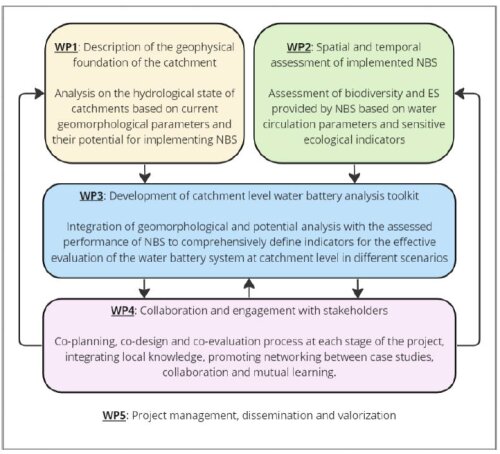RECHARGE is based on the study of the water battery under a ‘whole catchment approach’. This is the double understanding that rivers cannot be managed in isolation from social aspects, and that water flows should be managed at the hydrological catchment level. This holistic approach acknowledges both the biophysical and anthropogenic aspects as one complex system. In order to study the whole catchment, the non-restored part of the catchment will be compared to the section of the river where NBS have been implemented. This will allow the comparison between two states of a river (before and after the restoration).

Firstly, an analysis of the natural, anthropogenic and climatic foundation will be performed for each study catchment (WP1). This is particularly important in those cases in which the stability of local actors and vulnerable communities rely on regional water availability;
Secondly, given the great importance to guarantee water security in these situations, we will assess the effects of implemented NBS through a spatiotemporal approach on water physicochemical and quantitative properties and ES (WP2);
Thirdly, indicators would be developed to understand the extent to which the potential of the water battery is being used to provide ES and whether or not there is a healthy balance with water use and abstraction (WP3). Landscapes with different soils and slopes would vary on the potential of their water battery. For example, the water battery will be smaller in shallow soils than on deep sandy soils, and the water battery will drain faster on hilly areas than in flat ones. The indicators would therefore reveal:
- the size of the battery (storage capacity of the landscape);
- the recharge potential of the battery (groundwater recharge and river flow dynamics);
- the battery leakage (groundwater drainage and decline of river’s water levels);
- the battery use (anthropogenic water abstraction and ecosystem water utilization);
- the impacts on biodiversity and ES (thresholds for ES delivery and biodiversity support and impacts);
- the implications on the Water Framework Directive (WFD) and Habitat Directive (ecological status).
Fourthly, the engagement of stakeholders (i.e., private sector, government, conservation organizations, water managers, landowners, communities, researchers of the area, among others) is considered crucial throughout this process and we will participatorily design a whole catchment strategy for the implementation of NBS focused on mitigating the effect of extreme hydrological events and the functioning of the water battery (WP4).